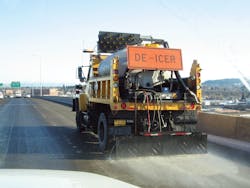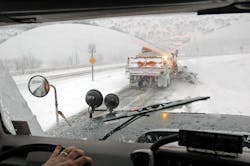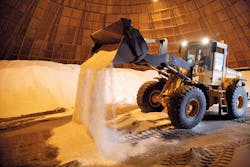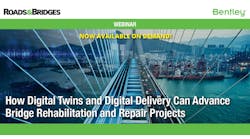By: Wes Alwan; Contributing Author
Since the 1970s, the staple deicing material for state departments of transportation has been chlorides, usually sodium chloride in the form of rock salt, and sometimes liquid salt brine or other chemicals.
Anti-icing, the use of liquid chemicals to treat the road prior to snowstorms, is a best practice that can significantly reduce the amount of rock salt and plowing required to remove snow and ice after a storm. (Photo/Virginia DOT)
In 2013, agencies applied about 17 million tons of salt to roadways in the U.S., according to the Salt Institute.
Not surprisingly, the use of salt in such quantities has environmental implications, and winter-maintenance professionals are increasingly concerned about minimizing these impacts. Salt can damage vegetation by burning leaves, reducing growth, interfering with nutrient absorption and causing premature leaf drop in conifer trees. It also can corrode vehicles and infrastructure; affect the sodium levels of drinking water; and have other negative impacts on water, wildlife, soil and air.
Despite these concerns, salt is here to stay. “The winter-maintenance community can’t move away from salt, because there’s no product of a similar price that can provide the same level of service,” said Laura Fay, a leading researcher in snow and ice control environmental impacts at Montana State University’s Western Transportation Institute (WTI).
Agencies therefore strive for solutions that balance level-of-service requirements with environmental impacts. “We want people to be able to get where they’re going as safely as possible,” said Brian Burne, highway maintenance engineer at the Maine Department of Transportation. “But we also don’t want to use more chlorides than necessary.”
Since the success of other best practices hinges on implementation by personnel, training staff and contractors on proper materials, application is critical to reducing environmental impacts. (Photo/Minnesota DOT)
Proper materials storage—including covering materials and keeping them on impermeable surfaces—is important to preventing groundwater contamination. (Photo/Virginia DOT)
This balancing act involves a series of best practices that agencies have developed over the years to select the right approach for the conditions and to more precisely control how materials are applied. But while there is a plethora of information on such practices, it is spread among numerous reports, and often not available in a practical, usable form for practitioners.
“Many winter-maintenance professionals feel like they are presented with a lot of information on environmental impacts and best practices, but aren’t told how to implement them, or how they affect their level of service,” Fay said.
Burne agreed. “There’s been so much going on—so many great practices, and a lot of different states making advances and trying out new things,” he said. “But what we lacked was something simple and straightforward, so people could understand the pros and cons of different kinds of materials and practices.”
One-source guidance
The Clear Roads winter-maintenance research consortium recently set out to fill that void. Clear Roads, a national pooled fund research program (TPF-5 [218]), sponsored a project to develop a manual that would gather all information into one place.
Published in July, the Snow and Ice Control Environmental Best Practices Manual serves as a practical tool for winter-maintenance professionals who want to optimize their programs to minimize environmental impacts. To develop the manual, a team of researchers headed by Laura Fay of WTI conducted a literature review and surveyed practitioners. Their goal was to compile and synthesize information on:
The use of chemical deicers and abrasives and their effects on air, surface and ground water, roadside soils, flora and fauna; and
Cost-effective equipment, practices and strategies for minimizing the use of deicing materials while maintaining the desired levels of service.
The team also surveyed snow and ice control professionals and operators concerning lessons learned and best practices, and interviewed six survey respondents as a basis for case studies that were incorporated into the manual.
Less salt, same level of service
Researchers found that the most efficient way for agencies to minimize environmental impacts is to reduce their use of deicing materials via a combination of effective application strategies, equipment calibration and training.
“In Montana we’ve spent a lot of time educating and training operators on reasonable application rates,” said Justun Juelfs, winter maintenance specialist at Montana Department of Transportation and vice chair of the Clear Roads technical advisory committee (TAC). “Along with calibrating equipment, this has helped us drastically reduce the amount of material we use.”
According to Fay, many agencies calibrate equipment only once a year, but more frequent calibration is often required. This manual discusses those situations. Another key practice is pre-wetting material as it is dispensed, which can be a very cost-effective way to dramatically reduce environmental impacts. “Pre-wetting allows for better placement and retention,” Juelfs said, “so you don’t need as much material to get the same level of service.”
Small changes can make a big difference. “A Michigan study found that just by driving at a reasonably slow speed of 25 mph and putting out pre-wetted material instead of dry, practitioners can ensure that close to 100% of the product will stay on the road,” Fay said. “But if you drive 45 mph and don’t pre-wet, you’ll lose 40% of the product.”
One of the most important environmental practices for winter maintenance is calibrating salt spreading trucks so that they dispense no more than the amount of salt necessary to maintain the desired level of service. (Photo/Minnesota DOT)
By using such strategies, agencies have seen significant reductions in the amount of materials they use. In the last 10 years, installing pre-wetting equipment and increasing calibration have allowed the Rhode Island Department of Transportation (RIDOT) to go from using an average of 400 lb of salt per lane-mile per application to 150 lb last winter, according to Joe Baker, RIDOT’s acting deputy chief engineer and a Clear Roads TAC member. “Just this past season we saw record lows for the application rate of materials used,” he said.
Reducing material use is not the only way to minimize environmental impacts. “Good housekeeping at salt storage facilities—keeping them clean, well-organized and well-maintained—is an important part of protecting the environment,” Fay said. This means making sure that salt and other deicing chemicals are covered and stored only on impermeable surfaces. Fay noted that while larger facilities generally do a great job in this area, many smaller facilities still need to catch up.
Proven strategies
By illustrating the benefits of best practices, the Clear Roads manual is a useful tool for overcoming the kind of cultural resistance that can prevent change. “There’s a lot of technology and training that comes with optimizing anti-icing practices, meaning that agencies can sometimes resist change when they improperly apply practices and find they don’t work,” said Burne, who also is a Clear Roads TAC member. “This information is meant to help educate practitioners on how to successfully implement these practices, and show them that they are effective when used properly.”
Fay agreed. “To get agencies to make changes, it’s a matter of showing that investments in new technologies and the greater work involved in calibration will pay off with material and other savings,” she said.
The manual’s case studies allow agencies to realistically assess the benefits of a new approach. Demonstrating benefits has been crucial to change at RIDOT, Baker said. “There’s less cultural resistance and more buy-in from our workers now that the road still looks good at lower application rates,” he said. “The budget numbers are also easier to swallow. We’ve had new equipment pay for itself with savings on material costs.”
Many local agencies don’t have the budget to test new technologies and practices in order to see these benefits. “They have to get it right the first time,” Baker said, “which makes this manual especially useful to these agencies.
Beyond illustrating the benefits of new practices, the manual clearly shows associated costs, Juelfs said. “What I like about this manual is that it doesn’t sugar-coat [things],” he said. “Everything we do has some level of environmental impact, but it’s not an option to not provide service, so what are the alternatives?” The manual shows how various practices affect levels of service, allowing practitioners to protect the environment while continuing to do a job they know is vitally important.
Practicality
As a practical synthesis of the large amount of available information on winter maintenance and the environment, the manual is a valuable reference for snow and ice managers and public works directors, Burne said. “There’s been a lot of research on environmental best practices for snow and ice control,” he said. “If you have too many specialty reports that are all self-standing, they can get lost in the mix. So a document like this is a useful tool—it gives a broad overview of all the practices and serves as a reference for those who want to dig deeper.”
The manual also serves as a resource for educating other agencies and the public, as well as justifying spending. “We frequently field questions from environmental agencies about what deicing materials do to the environment, and what can be done to minimize impacts,” Baker said. “This manual gives us an easy way to point them to examples and research.”
With this reference at hand, agencies can operate on the idea that reducing environmental impacts, controlling costs and maintaining levels of service are complementary goals.
“We can’t quit doing our job, and we have a commitment to the traveling public to strike a balance between safety, mobility, cost and the environment,” Juelfs said. “The Snow and Ice Control Environmental Best Practices Manual does a good job capturing all those concerns.” WM
About The Author: Alwan is with CTC & Associates, a technical communications consulting firm in Madison, Wis.






